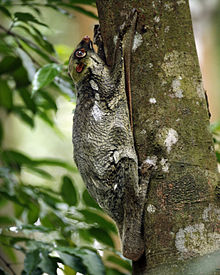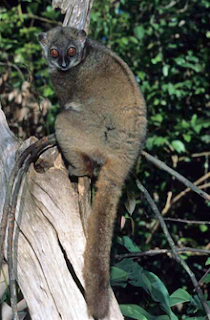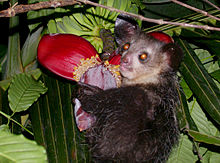 |
| Ring-Tailed Lemur |
One of the most important groups of primates to be seen at Bristol or any other zoo is the lemurs of Madagascar. Confined only to that island (with human introduction of one species to the Comores) they represent a unique radiation of primates in isolation from other primate species, a process which has been going on for many millions of years, possible even before the extinction of the dinosaurs. After thriving on the islands for all that time, around 2000 years ago they encountered disaster in the form of human colonists (not from nearby Africa, but from clear across the Indian ocean in Indonesia). Since that time, many species have become extinct, and the rest are all highly threatened.
 |
| Tree Shrew - not a primate |
Although they are primates, lemurs are not monkeys, but instead belong to the same branch of the primate tree that include the galagos (bushbabies) of Africa and the lorises of Asia. The very earliest primates known were small, nocturnal, rather squirrel-like animals like
Purgatorius from North America, which in life probably resembled one of the tree shrews
Tupaia found in south east Asia. In fact, tree shrews were once considered primates themselves, but are now placed in the separate order Scandentia. Other near-primates are the ‘flying lemurs’ or Colugos, now placed in the order Dermoptera. More distant relatives include rodents and lagomorphs, and together with the primates they make up the clade Euarchontaglires. When this group as a whole originated is not clear, but was probably in the mid-Cretaceous around 85mya.
 |
| Colugo - also not a primate |
At a very early point in their history, the primates split into two branches. One, the haplorrhines, led to monkeys, apes, and eventually us. They became on the whole much larger, diurnal, and tend to have larger brains and are more inclined to manipulate their environment. The other branch, called the strepsirrhines, retained the ancestral nocturnal niche and small body size, and tend to take their environment as they find it – as far as I am aware there are no cases of a strepsirrhine using a tool, even in captivity, whereas monkeys and apes will at least occasionally use them.
Instead of developing tool use, the strepsirrhines developed a useful modification of their lower incisors called the tooth comb, which is used in grooming their fur and also in gouging plant stems and tough-shelled fruits. Unlike the haplorrhines, they have a ‘wet’ nose like a dogs, which improves scent detection (smell is a more important sense than sight in a nocturnal animal).
Perhaps around the end-Cretaceous impact, the strepsirrhines in turn split into two branches. One became the lorises and galagos of mainland Africa and Asia, the other became ancestral to modern lemurs. It seems most likely that the cause of the split was the colonisation across the Mozambique Channel by the ancestral lemur in a single event, but it is possible the split occurred on the mainland and there were multiple colonisations by groups ancestral to the various families of lemurs found today. Unfortunately fossil evidence is rare for any primate, and there are no known fossil deposits from Madagascar for the key dates.
In the absence of fossil evidence, DNA analysis has come to the rescue, and the modern lemurs can be divided into five families, with an additional three families of recently extinct lemurs wiped out by humans in the last 1000 years or so.
1) Cheirogaleidae (mouse lemurs) – these are very galago-like and are the most conservative of the lemur families). Bristol has one species, and has bred them repeatedly
 |
| Grey Mouse lemur |
2) Lepilemuridae (sportive lemurs) – mostly cat-sized or smaller, and specialise in eating foliage. As a result of their specialised diet, they appear to be hard to maintain in captivity, and very few collections have them. They are a very speciose group, with at least 26 species described.
 |
| Sahamalaza Sportive Lemur |
3) Megaladapidae (the extinct giant lemur) – probably closest to the sportive lemurs, it reached 50kg and seems to have had a rather koala-like lifestyle.
 |
| Megaladapis |
4) Archaeolemuridae (extinct ‘baboon’lemurs’) – these were quite terrestrial, unlike almost all other lemurs
 |
| Archaeolemur |
5) Indriidae – living indris, avahis, and sifakas. These are the largest and most spectacular of the surviving lemurs, and are famed for their noisy calls and amazing leaping abilities. There are very few species in captivity, although there is a small population of Crowned Sifaka in a few zoos worldwide.
 |
| Crowned Sifaka |
6) Palaeopropithecidae – extinct sloth lemurs and allies. These were large lemurs, reaching 35kg, and were highly arboreal. A legendary Malagasy animal, the tretretretre, may be this animal. Descriptions of an animal called a kidoky in a folklore survey in 1995 near Belo sur Mer were sufficiently close to one of these creatures it is possible that they even survived as recently as the 1950’s, which is when one of the interviewees claimed to have encountered one. He even recalled its call, which was similar to an Indris'.
 |
| Palaeopropithecus |
7) Lemuridae – the ‘standard’ lemurs (Ring-Tailed Lemur, Red-Ruffed Lemur and others). Almost all the lemurs to be seen in zoos belong to this group.
8) Daubentoniidae – the Aye-Aye. Perhaps the most famous (certainly the weirdest-looking) of all lemurs, indeed of all primates, it is also the most evolutionarily distinct, with an estimated divergence time from the other lemur species suspiciously close to the end-Cretaceous impact, though what the significance of that is I have no idea. Bristol is one of the few zoos in the world to hold the species, and we have bred them on two occasions.
 |
| Aye-Aye |
Via the AEECL, whose work I outlined in last week’s post, Bristol is currently funding conservation and research into various lemurs in Sahamalaza in Madagascar, as well as being involved in ex-situ breeding programmes for the seven species we currently have in the collection. In the coming weeks, I will be running a series of posts on the lemurs we have here, some other species you may be lucky enough to see at other zoos, and what can be done about the dire state of these unique primates.
(images from wikipedia, Bristol Zoo website)










Lovely post :)
ReplyDeleteHere's some Lemur's I snapped a while back at a wee zoo not far from where I live in Auckland, New Zealand. Franklin Zoo and wildlife sanctury. Sadly now this zoo which took in unwanted and aged animals is having to close because Mila [it's elephant] accidentally killed Helen the keeper [and trustee] -an amazing lovely woman who i had the priviledge to meet on a visit there. Her passion for the animals will always be emblazoned on my mind. They are fighting hard for Mila to go overseas to America.
Lemur
http://www.flickr.com/photos/porkynz/4576170325/
Mila
http://www.flickr.com/photos/porkynz/4576164817/
About the closure
http://tvnz.co.nz/national-news/franklin-zoo-closes-after-seven-years-4968216
The zoo website
http://www.franklinzoo.co.nz/
Cheers
Sandy